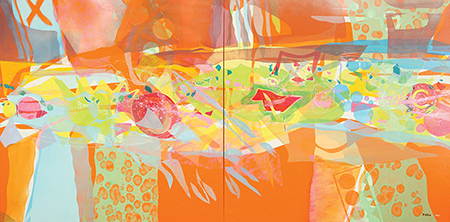
Continuing through May 25, 2014
The question of midcentury modernist abstraction in the Pacific Northwest is still being answered as museums and art historians display previously undervalued women artists of the period and show them off to best advantage. “A Punch of Color: Fifty Years of Painting by Camille Patha” is a good example. Chief curator Rock Hushka and TAM curatorial fellow Alison Maurer try to contextualize Patha’s career as part of the very real struggle by women artists, students and faculty (or lack thereof) at the University of Washington School of Art in Seattle. Patha’s BA was awarded in 1960 and her MFA in 1965. Seen against the polemics of Maurer’s catalogue essay, the exhibition is a triumph over sexist adversity. Looked at without such hindsight, Hushka’s careful chronological selection is a triumph over diversity and numbers. He’s found representative works of Patha’s many different series, but has had to omit a few series that I miss, such as the “Beach Fever” paintings.
If it is at all possible to make a generalization about women artists any longer, my experience suggests that they do not evolve stylistically in strictly linear ways and that they feel free to backtrack, revive, and refine earlier strains and ideas. Given this, Hushka’s exhibit design manages to create maximum clarity out of a body of work that can seem one of considerable complexity and contradiction.
Without repetition, singular examples of major series over at least 40 years give the viewer a chance to appreciate not only Patha’s variety, but her ingenious oscillations between abstraction and representation. Drilled as an abstract expressionist as a student, she found refuge in visiting professors: New Yorker Charles Cajori (a pal of de Kooning’s) and Herbert Siebner, a central European figurative-expressionist transplanted to Canada. Both stressed the co-existence of figuration and abstraction and encouraged the young student’s unfettered flair for color.
Judy Chicago, who met the artist in 1974, the year before publication of her book “Through the Flower,” wrote the preface for my 2006 book on Patha, “Geography of Desire.” Both artists have roots in 1970s era West Coast abstraction, yet one turned toward more explicitly gendered imagery and the other, Patha, gravitated to encoded and erotically symbolic allusions. Patha’s mid-period floral still lifes and beach landscapes highlight cut-open pomegranates, dripping with juice, or solitary wild birds. Meant for male and female viewers, a painting like “Genesis” (1980) has pink breast shapes but its ostensible subject is male-female procreation — the dawn of life in the natural world. Elsewhere, cherries stand in as comical genitalia (as in “Pie in the Sky” [1973], and “An Honest Self-Portrait After 1974” [1976]), as do oranges in “Generalife” (1977-78) and apples in “The Conductor” (1975). The point is, regardless of Maurer’s placing Patha in the narrow feminist-academic continuum of her essay, the artist, now 75, has repeatedly rejected such affinities in interviews, much as she and Chicago discussed in 1974.
More pertinently, Patha’s identification with wild and endangered birds emerged in her paintings of the 1980s, launching an interest in ecology that lasted over a decade. Darkened seascapes with proud herons and ravens dominate the segmented compositions of “Ancestral Spirit Bird” (1985) as well as a self-portrait, a triptych with a solemn white heron sheltered from nuclear-toxic sunsets.
With her studio perched on a cliff overlooking Puget Sound in Normandy Park, WA since 1971, Patha has taken inspiration from local wildlife and the intoxicating grandeur of nature and its maritime expanses. These become metaphors of consciousness and an awareness of the symbiosis of animals and humans. Patha’s art is a mélange of pictorial and painterly ideas first and foremost; social or ideological impulses are secondary. The ambiguity of the imagery derives from West Coast Surrealism as well as from Belgian Magic Realists Rene Magritte and Paul Delvaux (see Patha’s “Walled Venus” [1975]): dark, mysterious and seductive female nudes.
Her late-period, current work is a riposte to the early New York School influences, channeling modernism into highly individual forms of subjective expression. Five decades on, Patha is further refining abstraction in works of the past decade, such as “Bordeaux Passage” and “Lucent Thicket” (both 2005). “Tropican” (2009-10) and “Yella Thrilla” (2008) overlay brightly colored passages cutting into solid-color backgrounds of white, yellow, orange or green. The impact is one of dynamic, racing polygonal shards. Despite her current tendency toward citrus hues, I am sure Patha will get around to revisiting her darker, nighttime studio haunts as well. To visit both locales with her is an art lover’s considerable pleasure; retracing the odyssey of a lifetime, facing down an empty canvas — and acting.
